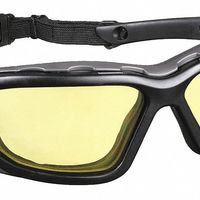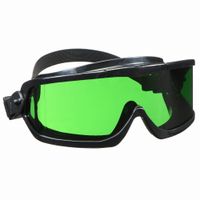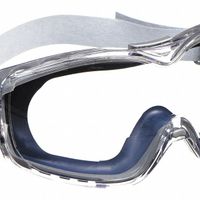Call +(254) 703 030 000 / 751 483 999 / 721 704 777
- Home
- Safety
- Eye Protection
- Safety Goggles
.....Read More
Frequently Asked Questions
What are the benefits of wearing protective goggles?
Protective goggles offer several benefits, primarily centered around safety and health. They provide a physical barrier that shields the eyes from hazardous materials, such as chemicals, dust, and debris, which are common in industrial, laboratory, and construction environments. This protection is crucial in preventing eye injuries that can result from splashes, flying particles, or exposure to harmful substances.
In addition to safeguarding against physical hazards, goggles also protect against harmful radiation. For instance, specialized goggles can filter out ultraviolet (UV) or infrared (IR) radiation, which is essential for individuals working with lasers or welding equipment. This protection helps prevent long-term damage to the eyes, such as cataracts or retinal burns.
Goggles also play a vital role in maintaining clear vision in challenging conditions. Anti-fog coatings and ventilation features ensure that the lenses remain clear, even in humid or high-temperature environments. This clarity is essential for maintaining productivity and accuracy in tasks that require precision.
Furthermore, protective goggles can be designed to fit over prescription glasses, ensuring that individuals with vision correction needs are not compromised. This adaptability makes them suitable for a wide range of users, enhancing their utility across different sectors.
In sports and recreational activities, goggles protect against impact and environmental elements like wind and water, reducing the risk of injury and enhancing performance. For example, in skiing or swimming, goggles improve visibility and comfort, allowing for better focus and enjoyment.
Overall, protective goggles are a critical component of personal protective equipment (PPE), offering comprehensive eye protection that enhances safety, performance, and comfort across various professional and recreational settings.
How do I choose the right lens color for my goggles?
Choosing the right lens color for your goggles depends on the lighting conditions and the activity you are engaging in. Here’s a guide to help you select the appropriate lens color:
1. **Bright, Sunny Conditions:**
- **Dark Lenses (Gray, Brown, Dark Green):** These colors reduce glare and provide true color perception, making them ideal for bright sunlight. They are suitable for skiing, snowboarding, or any outdoor activity in sunny weather.
2. **Low Light or Overcast Conditions:**
- **Yellow, Gold, Amber, or Rose Lenses:** These colors enhance contrast and depth perception in low-light conditions, such as cloudy or foggy days. They are excellent for skiing or snowboarding in overcast weather.
3. **Variable Conditions:**
- **Photochromic Lenses:** These lenses automatically adjust their tint based on the light conditions, darkening in bright light and lightening in low light. They are versatile for changing weather conditions.
4. **Night or Indoor Use:**
- **Clear Lenses:** Clear lenses provide protection without altering vision, suitable for night skiing or indoor sports.
5. **Water Sports:**
- **Polarized Lenses:** These reduce glare from reflective surfaces like water, making them ideal for activities such as fishing or sailing.
6. **High Altitude or Snow:**
- **Mirrored Lenses:** These reduce glare and are beneficial in high-altitude or snowy environments where sunlight is intense.
7. **Personal Preference:**
- Consider comfort and personal preference, as some people may find certain colors more soothing or visually appealing.
Always ensure the lenses provide 100% UV protection to safeguard your eyes from harmful rays. Additionally, consider anti-fog and scratch-resistant coatings for enhanced performance and durability.
Can protective goggles be worn over prescription glasses?
Yes, protective goggles can be worn over prescription glasses. Many safety goggles are specifically designed to fit comfortably over regular eyeglasses, ensuring that individuals who require vision correction can still benefit from eye protection in various environments. These goggles are often referred to as "over-the-glasses" (OTG) goggles.
OTG goggles are typically larger in size to accommodate the frame and lenses of prescription glasses. They feature a spacious interior and are designed with adjustable straps to ensure a secure and comfortable fit. The lenses of OTG goggles are usually made from impact-resistant materials like polycarbonate, providing protection against debris, chemicals, or other hazards.
To prevent fogging, which can be a common issue when wearing goggles over glasses, many OTG goggles come with anti-fog coatings or ventilation systems. This feature helps maintain clear vision by reducing moisture buildup inside the goggles.
When selecting protective goggles to wear over prescription glasses, it is important to consider the following factors:
1. **Fit and Comfort**: Ensure the goggles fit well over your glasses without causing discomfort or pressure on your face or temples.
2. **Lens Quality**: Look for goggles with high-quality, impact-resistant lenses that offer clear vision and protection.
3. **Anti-Fog Features**: Choose goggles with anti-fog coatings or ventilation to prevent fogging.
4. **Adjustability**: Opt for goggles with adjustable straps to achieve a secure fit.
5. **Compatibility**: Make sure the goggles are compatible with the size and shape of your prescription glasses.
By choosing the right pair of OTG goggles, individuals can ensure both their vision and eyes are adequately protected in environments that require safety eyewear.
How do I ensure a proper fit for my protective goggles?
To ensure a proper fit for your protective goggles, follow these steps:
1. **Size and Adjustability**: Choose goggles that match your face size. Look for adjustable straps and nose pieces to customize the fit.
2. **Seal**: Ensure the goggles form a tight seal around your eyes. There should be no gaps between the goggles and your skin to prevent particles from entering.
3. **Comfort**: The goggles should sit comfortably on your face without pinching or causing pressure points. Check for padding around the edges for added comfort.
4. **Strap Tension**: Adjust the strap so that it is snug but not too tight. It should hold the goggles securely in place without causing discomfort.
5. **Lens Position**: The lenses should be centered over your eyes, providing a clear and unobstructed view. Adjust the nose piece if necessary to align the lenses properly.
6. **Anti-Fog Features**: Ensure the goggles have anti-fog coatings or ventilation to prevent fogging, which can impair vision.
7. **Compatibility with Other PPE**: If wearing other personal protective equipment (PPE) like helmets or masks, ensure the goggles fit well with them without causing interference.
8. **Testing**: Move your head in different directions to test the stability of the goggles. They should remain in place without shifting.
9. **Regulatory Standards**: Check that the goggles meet relevant safety standards for your specific needs, such as ANSI Z87.1 for impact resistance.
10. **Trial Period**: Wear the goggles for a short period to ensure they remain comfortable and effective over time.
By following these guidelines, you can ensure that your protective goggles fit properly, providing maximum safety and comfort.
Are there goggles with built-in magnification for reading?
Yes, there are goggles with built-in magnification designed specifically for reading and other close-up tasks. These are often referred to as magnifying goggles or reading goggles. They combine the functionality of safety goggles with the magnification power of reading glasses, making them ideal for individuals who need to protect their eyes while also requiring magnification for detailed work.
These goggles typically feature lenses with varying magnification strengths, similar to reading glasses, allowing users to choose the level of magnification that best suits their needs. They are particularly useful for activities such as reading small print, crafting, sewing, or any task that requires enhanced visual clarity.
Some models come with adjustable magnification, enabling users to switch between different levels of magnification depending on the task at hand. Additionally, these goggles often include features like anti-fog coatings, UV protection, and adjustable straps for a secure fit, enhancing both comfort and functionality.
Magnifying goggles are available in various styles and designs, catering to different preferences and requirements. They can be found in specialty stores, optical shops, and online marketplaces, offering a range of options in terms of price and quality.
Overall, magnifying goggles provide a convenient solution for those who need both eye protection and magnification, combining practicality with enhanced visual assistance.
What are the differences between clear, dark, amber, and green lenses?
Clear lenses are primarily used for protection without altering vision, ideal for indoor or low-light conditions. They provide a neutral view, ensuring no color distortion, and are often used in safety glasses or prescription eyewear.
Dark lenses, often referred to as sunglasses, are designed to reduce glare and brightness from sunlight. They come in various tints, such as gray or brown, and are suitable for outdoor activities. Dark lenses help in reducing eye strain and protecting against UV rays, but they can alter color perception slightly.
Amber lenses enhance contrast and depth perception by filtering out blue light. They are beneficial in low-light conditions or overcast weather, making them popular for activities like skiing, cycling, or shooting. Amber lenses can make surroundings appear warmer and are not ideal for color-sensitive tasks.
Green lenses offer a balance between contrast enhancement and color accuracy. They reduce glare while maintaining true color perception, making them suitable for a variety of outdoor activities, including golf and tennis. Green lenses provide good protection against UV rays and are comfortable for prolonged wear in bright conditions.
How do I clean and maintain my protective goggles?
To clean and maintain your protective goggles, follow these steps:
1. **Initial Rinse**: Rinse the goggles under lukewarm water to remove loose debris and dust. Avoid using hot water as it may damage the lens coating.
2. **Cleaning Solution**: Use a mild soap or a specialized lens cleaning solution. Apply a small amount to the lenses and gently rub with your fingers. Avoid using harsh chemicals or abrasive cleaners that can scratch or damage the lenses.
3. **Rinse Thoroughly**: Rinse the goggles again under lukewarm water to remove all soap or cleaning solution residues.
4. **Drying**: Shake off excess water and gently pat the goggles dry with a clean, soft microfiber cloth. Avoid using paper towels or rough fabrics that can scratch the lenses.
5. **Anti-Fog Treatment**: If your goggles have an anti-fog coating, ensure you use products compatible with it. You can also apply an anti-fog spray or solution if needed, following the manufacturer's instructions.
6. **Storage**: Store the goggles in a protective case or a soft pouch to prevent scratches and exposure to dust. Keep them in a cool, dry place away from direct sunlight and extreme temperatures.
7. **Regular Inspection**: Regularly inspect the goggles for any signs of wear, such as scratches, cracks, or loose straps. Replace them if they are damaged or if the lenses are significantly scratched, as this can impair vision and reduce protection.
8. **Avoid Touching Lenses**: Minimize touching the lenses with your fingers to prevent smudges and fingerprints.
By following these steps, you can ensure your protective goggles remain in good condition, providing optimal protection and clear vision.





